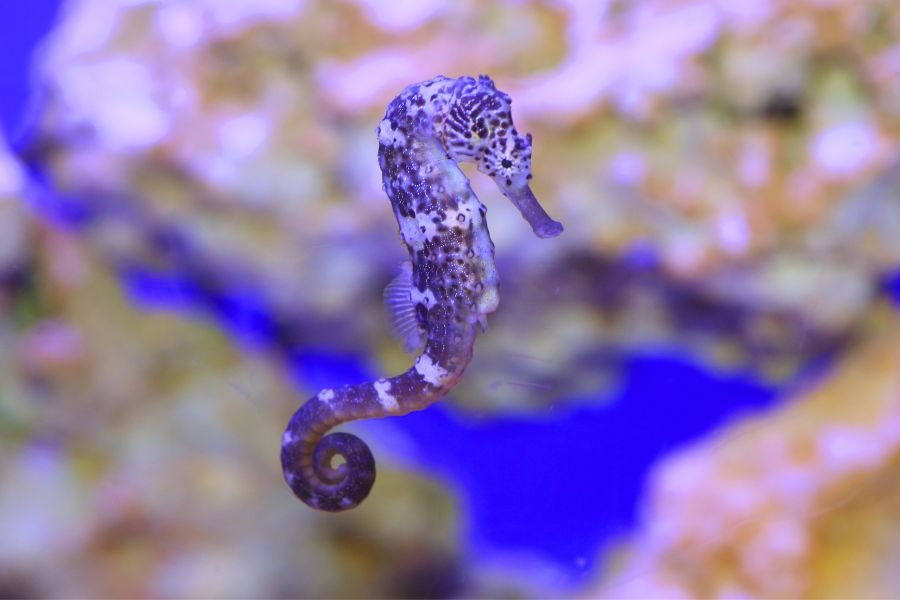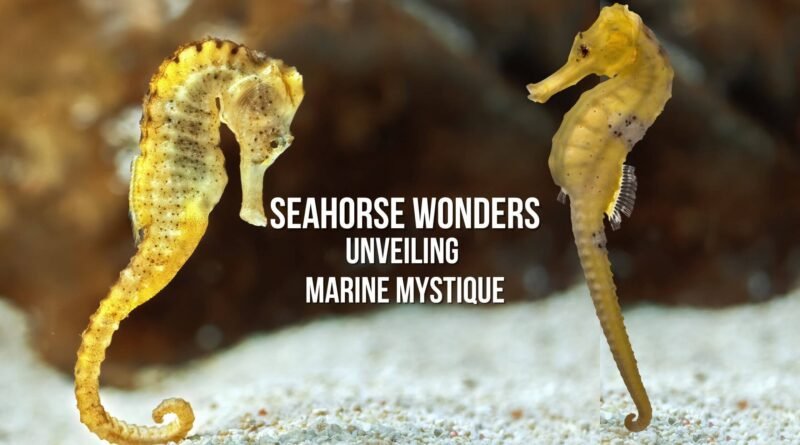Seahorse: Submarine Wonders and the Mystery of Their Lives
Seahorses, these mysterious creatures of the marine kingdom, have always captivated the imagination of those fortunate enough to witness them in their majestic underwater dance. With their peculiar shape and graceful movements, these marine animals hold a special place in marine ecology and popular culture.
In this article, we will delve into the fascinating world of seahorses, exploring their uniqueness and their crucial role in marine ecosystems.
Unlike many other ocean inhabitants, seahorses do not share the imposing physical characteristics and notoriety of sharks or dolphins, but that does not make them any less intriguing. In fact, these unique aquatic creatures possess a range of remarkable adaptations that help them thrive in their marine habitat.
Known for their distinctive body structure and their appearance resembling that of land horses, seahorses are true examples of the diversity and complexity of marine life. Besides their unique appearance, seahorses also play a crucial role in coastal ecosystems, contributing to the balance of marine life.
Let’s explore how these small beings perform vital functions, such as predation and protection, and how their delicate lives are interconnected with the fundamental elements of the underwater world.
So, get ready for a journey through the fascinating intricacies of the seahorse, a creature that inspires admiration and respect in the hearts of all who explore the secrets of the ocean.

Seahorse: Get to Know this Fascinating Bony Fish
The seahorse, or Hippocampus, belongs to the family Syngnathidae, which also includes pipefish and sea dragons. They are part of the order Syngnathiformes, which stands out for its unique characteristics. This order harbors a variety of marine species that share common traits, such as the long, slender body and horse-shaped head.
Diversity Within the Seahorse Species
Seahorse species are numerous, varying in size, color, and shape, each with its own beauty and peculiarities, making this group of fish truly fascinating. Currently, there are 54 known species of seahorses distributed throughout the world’s oceans.
One of the most famous and easily recognizable seahorse species is the Common Seahorse (Hippocampus hippocampus). Despite its name, this species is classified as “Vulnerable” on the IUCN Red List due to habitat destruction and overexploitation for trade.
Anatomy of a Seahorse: The Bony Structure
The seahorse is a bony fish. Bony fish, scientifically known as osteichthyes, are a group that includes most of the fish species known today. The name ‘Osteichthyes’ is derived from Greek, meaning ‘bone’ and ‘fish’, hence bony fish. These fish are characterized by the presence of a hardened skeleton formed by bones, unlike cartilaginous fish like sharks and rays, whose skeletons are formed by cartilage.
In seahorses, this bony skeleton provides structure and protection, supporting their long, slender bodies and allowing their elegant movement through the waters. The existence of a bony skeleton also contributes to the uniqueness of their shape, giving them the characteristic appearance that distinguishes them from other ocean inhabitants.

Physical Characteristics
Seahorses exhibit a series of distinct physical characteristics that make them unique among fish. Their long, curved bodies, culminating in an elongated head resembling that of a horse, are covered by a rigid armor of bony plates, which provides protection against predators.
They have eyes that move independently of each other, allowing them a 360-degree view of their environment. The prehensile tail of seahorses is another striking feature, used to grip onto marine plants and other substrates, helping them to stay in place in strong currents.
Additionally, unlike most fish, seahorses do not have scales, but rather smooth or slightly rough skin stretched over their bony structure. Sexual dimorphism is also notable in these creatures, with males possessing a unique brood pouch in which they carry and hatch the eggs.

Habitat
Seahorses are found in a variety of marine habitats around the world, from shallow, warm tropical waters to colder, deeper waters. They tend to prefer coastal areas, such as mangroves, seagrass meadows, coral reefs, and estuaries, where underwater vegetation is abundant.
These areas provide cover and protection against predators, as well as being rich in food, such as small crustaceans. The prehensile tail of the seahorse facilitates their grasping onto marine plants and other substrates, allowing them to “anchor” in strong currents.
Surprisingly adaptable, seahorses have been found in a variety of environments, including even brackish and hypersaline waters. Preserving these delicate habitats is crucial for the survival of these fascinating and intricately beautiful creatures.

Feeding
Seahorses have a considerable appetite and are voracious predators. They primarily feed on small crustaceans, such as copepods and amphipods, and a variety of zooplankton. Equipped with a tubular, toothless mouth, seahorses suck their prey in a quick and nearly invisible movement.
This feeding method, known as suction feeding, allows them to capture small organisms directly from the surrounding water or nearby substrates.
Due to the absence of a stomach, seahorses need to constantly eat to maintain their energy levels, making them active and persistent predators in their habitat.

Behavior
Seahorses, belonging to the genus Hippocampus, are known for their unique mating rituals and complex social behavior. They form monogamous pairs during the breeding season, and both partners engage in morning mating dances. During these rituals, seahorses may change color and intertwine their tails, strengthening their bond.
One distinctive feature of seahorse species is that the male is responsible for carrying the female’s eggs in his brood pouch until they give birth. This behavior sets seahorses apart from many other fish species and showcases the complexity of their reproductive life.
Seahorses rely on seagrass beds as feeding grounds and habitats, but their populations face threats like reducing viable habitats. With an estimated one million seahorses in the wild, these unique creatures play a crucial role in marine ecosystems.
In addition to their unique behaviors, seahorse species exhibit elaborate courtship displays, with males circling females and engaging in dances. The gestation time varies among species, highlighting the diversity within the seahorse life cycle.
Seahorses, often dubbed as “sea monsters” due to their unique appearance resembling tiny horses, are poor swimmers with delicate bodies and tiny pectoral fins. They are vital to the underwater world, showcasing the beauty and diversity of marine life.

Seahorse Reproduction
Seahorse reproduction is unique and fascinating, primarily distinguished by the reverse roles of the sexes. The process begins when the female deposits her eggs into the male’s brood pouch. This pouch is a specialized organ that provides the perfect environment for egg development, supplying nutrients and oxygen, as well as protecting the future little seahorses. After receiving the eggs, the male fertilizes them and carries them for a period ranging from two to four weeks, depending on the speces.
Birth and Independence
When the offspring are ready to be born, the male undergoes a series of muscular contractions to expel them from the pouch. Once born, the tiny seahorses are completely independent, and parental care ends. It is a truly remarkable reproductive cycle that exemplifies the diversity of reproductive strategies in the animal kingdom.
Diversity Among Species and Conservation
The male seahorse belongs to the genus “Hippocampus.” There are several species of seahorses, each with its own mating ritual and unique characteristics. Seahorses are fascinating animals, with elongated bodies, prehensile tails, and peculiar fins. They are known for their coastal habitat, living in areas of coral reefs, seaweed, and estuaries.
The Circle of Seahorse Life
Females deposit their eggs into the male’s brood pouch, where gestation occurs. During this period, males provide all the necessary nutrients and oxygen for the development of the offspring. After gestation, males undergo muscular contractions to release the offspring into the water.
Seahorse reproduction exemplifies the incredible diversity of reproductive strategies that exist in the animal kingdom. It is a fascinating process that highlights the importance of the protection and conservation of these unique species.

Conservation Status
Seahorses are currently facing a number of threats that have resulted in their decline in various parts of the world. Habitat destruction, primarily due to pollution and coastal development, along with the practice of overfishing for use in traditional medicine, aquaculture, and even as tourist souvenirs, has contributed to the vulnerability of these species.
Urgent Need for Protective Measures
The International Union for Conservation of Nature and Natural Resources (IUCN) lists several seahorse species as ‘Vulnerable’ or ‘Endangered’, highlighting the need for rigorous conservation measures.
To protect these unique and fascinating creatures, it is crucial to implement and enforce sustainable fishing regulations, promote habitat conservation, and increase public awareness of the importance of seahorses in the marine ecosystem.

Conclusion
Seahorses are truly unique creatures, endowed with fascinating physical characteristics, behaviors, and reproductive strategies. Seahorse survival is threatened by various factors, including habitat destruction and overfishing. Effective measures must be taken to protect seahorse species and the rich and diverse habitats they occupy. Cooperation from conservation organizations, governments, local communities, and the general public is essential. By raising awareness of the importance of seahorses in the marine ecosystem and the urgent need for their protection, we can help ensure that these exceptional creatures continue to thrive in the world’s oceans.




